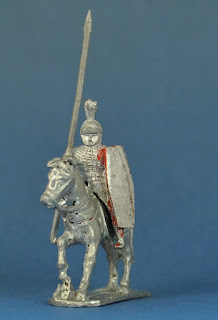I've not managed to get much done for a few weeks, either by way of painting or updates for this blog, what with one thing or another, so I thought I'd share these few pieces I've painted as samples. Before starting on a new unit I like to paint up one figure first, just to work out what colours to use and whether there's anything I need to watch out for. Often I don't spot a mould line until it's too late - but if you know what to look out for you can make sure the rest get dealt with. Also, sometimes a colour doesn't quite work out, and you can correct it before committing to a whole unit.
I've managed to get enough of the Successor Phalangites ready to paint a whole phalanx of 48 figures. Must admit the prospect is a bit daunting though - so maybe I'll leave this until I'm feeling brave.
This one had suffered a broken butt (which as we all know is not something to be taken lightly) which I've repaired with a length of brass wire. Can you tell? A good layer of paint helps.
The figure itself is modelled with what is intended to be a bronze breastplate, but I've painted it as a linothorax. I think it works pretty well and I prefer the look of it. The shoulder yoke isn't quite right for a linothorax - but we are dealing with 70s Minifigs so 'not quite right' is something we shouldn't worry about too much.
The shield transfer is from the Veni Vedi Vici (VVV) range and fits the shield nicely. A couple of layers of gloss varnish helps to seat the whole thing firmly in place.
This javelinman is actually from the later Minifigs range for Armies of the Macedonian and Punic Wars that appears in the 1978 catalogue. I'm mostly interested in collecting figures from the earlier ranges, but its quite common to find these later models mixed in with their earlier cousins and that is what has happened here.
As with our phalangite this chap arrived with the back end of his javelin missing and I've replaced it with wire. I've also managed to photograph the model from the only angle where you can see I've not quite aligned it true. Ah well - close enough without replacing the whole thing - and I do like to preserve the original where I can.
Briton slinger from the Armies and Enemies of Imperial Rome range. This is the figure I stripped and photographed in metal a bit back. I wanted to paint it up to see if I could cope with the odd bit of paint that refused to shift. I worked over the casting with a big hat pin - one of the most useful tools in the armoury - just picking out the odd bit of recalcitrant paint from the detail.
Seems to have turned out okay - though I don't really have enough Britons/Gauls to consider putting together a proper force just yet.
And another slinger - this one is a Roman from the old A series 'S' range Ancients that makes a last appearance in the 1972 catalogue. As slingers go he's about as generic as you can get and I'm sure I can find room for the rest of his mates as part of several armies.
Lastly we have a Carthaginian Cavalryman and once again I've chosen to paint his armour up as a linothorax rather than what was intended to be bronze.
This is a pleasing little figure and I was pleased with the way he turned out. I have a unit of twenty that I can add to my growing Carthaginian force - a mix of Carthaginians and Spanish. I never set out to collect Carthaginians but it seems to have just happened. Such is fate.
I like painting white - it's interesting to contrast the different shades. Here the crest is a plain black/white mix whilst the shield is white with a touch of ochre. The only trouble with mixing paint - as I do all the time - is you have to try and remember what you mixed when it comes to painting a new batch of figures. Still, variety is the spice and all that.
The shield transfer is from the Warlord Hoplite set and unfortunately you only get one of this particular design on the sheet! I may need to get a few more sheets if I want to have the same design throughout.



























